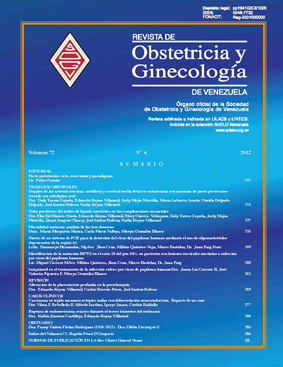Distribución de genotipos del virus de papiloma humano en mujeres del edo. Aragua, Venezuela
Palavras-chave:
Virus de Papiloma Humano, Chlamydia Trachomatis, Reacción en Cadena de Polimerasa, Genotipificación, CáncerResumo
Determinar los genotipos de virus de papiloma humano presentes en mujeres del Municipio Girardot, Edo.Aragua y la relación entre C. trachomatis, virus de papiloma humano y cambios neoplásicos. Se incluyeron 184 mujeres que acudieron para tamizaje de lesiones en cuello uterino y detección molecularde virus de papiloma humano y C. trachomatis, en el Hospital Central de Maracay. Se realizó hisopado vaginalpara la detección, por reacción en cadena de polimerasa, de ADN de virus de papiloma humano y C. trachomatis, ycitología. Se obtuvieron 48 muestras positivas para virus de papiloma humano (26,1 %), 12 % con un solo tipo y4,9 % con dos o más tipos. Se tipificaron 27 virus de alto riesgo, 18 de bajo riesgo y 17 indeterminados. Los genotiposfueron: 45 (5); 59, 57, 11 y 6 (4 cada uno); 16, 53 y 52 (3 cada uno); 58 y 26 (2 cada uno) y 73, 31, 51, 66, 68, 30,40, 42, 43, 44 y 83 (1 cada uno). Hubo 56 muestras positivas para C. trachomatis (30,4 %). La citología reportócambios en 13 muestras (5 lesiones de bajo grado, 1 de alto grado, 6 atipias de células escamosas y 1 atipia decélulas glandulares). Hubo relaciones estadísticas significativas entre la infección de VPH con respecto a la edad de laspacientes, pero no se encontró asociación significativa, de manera individual o conjunta, entre VPH y C. trachomatisy la aparición y/o progresión de lesiones neoplásicas.
To determine the genotypes of human papillomavirus present in women from Girardot Municipality, Edo.Aragua and the relationship between C. trachomatis, human papilloma virus and neoplastic changes. We included 184 women who attended screening of cervical lesions and molecular detection of humanpapillomavirus and C. trachomatis, at the Central Hospital of Maracay. Vaginal swab was performed for the detection,by polymerase chain reaction, of DNA from human papilloma virus and C trachomatis, and cytology. 48 positive samples were positive for human papilloma virus (26.1%), 12% with a single type and 4.9% withtwo or more types. We classified 27 high risk, 18 low risk and 17 undetermined viruses. The genotypes were: 45 (5);59, 57, 11 and 6 (4 each); 16, 53 and 52 (3 each); 58 and 26 (2 each) and 73, 31, 51, 66, 68, 30, 40, 42, 43, 44 and83 (1 each). There were 56 positive samples for C. trachomatis (30.4%). Cytology reported changes in 13 samples (5low-grade lesions, 1 high-grade lesion, 6 squamous cell atypia and 1 glandular cell atypia). It was statistically significant association between the presence of human papilloma virus and thepatient age. However, no significant association was observed between the infections, individually or together, withhuman papillomavirus and C. trachomatis and the appearance and / or progression of neoplastic lesions.

